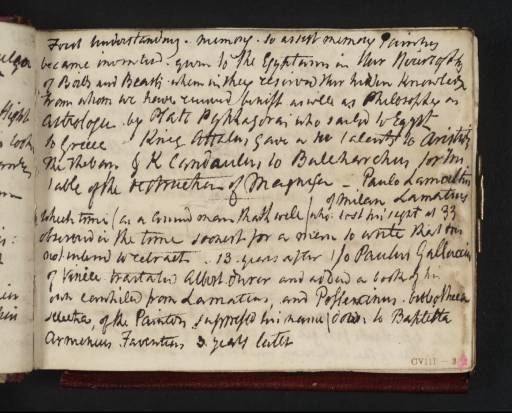Joseph Mallord William Turner Inscription by Turner: Notes on Art, from Giovanni Paolo Lomazzo; with a Sketch of a Kneeling Figure c.1809
Joseph Mallord William Turner,
Inscription by Turner: Notes on Art, from Giovanni Paolo Lomazzo; with a Sketch of a Kneeling Figure
c.1809
Joseph Mallord William Turner 1775–1851
Folio 2 Recto:
Inscription by Turner: Notes on Art, from Giovanni Paolo Lomazzo; with a Sketch of a Kneeling Figure circa 1809
D07357
Turner Bequest CVIII 2
Turner Bequest CVIII 2
Pen and ink on white wove paper, 88 x 115 mm
Inscribed by Turner in ink (see main catalogue entry)
Inscribed by John Ruskin in red ink ‘2’ bottom right
Stamped in black ‘CVIII – 2’ bottom right
Inscribed by Turner in ink (see main catalogue entry)
Inscribed by John Ruskin in red ink ‘2’ bottom right
Stamped in black ‘CVIII – 2’ bottom right
Accepted by the nation as part of the Turner Bequest 1856
References
1909
A.J. Finberg, A Complete Inventory of the Drawings of the Turner Bequest, London 1909, vol.I, p.288, CVIII 2, as ‘“First understanding, ...”’.
1982
Jerrold Ziff, ‘But Why “Medea” in Rome?’, Turner Studies, vol.2, no.1, Summer 1982, pp.18 note 5, 19.
1984
Jerrold Ziff, ‘Turner, the Ancients, and the Dignity of the Art’, Turner Studies, vol.3, no.2, Winter 1984, pp.45, 49 note 6.
1994
Maurice William Davies, ‘J.M.W. Turner’s Approach to Perspective in his Royal Academy Lectures of 1811’, unpublished Ph.D thesis, Courtauld Institute of Art, London 1994, p.287.
The whole page is taken up with the following notes:
First understanding, memory. to assist memory Painting | became invented. given to the Egyptians in their [... ?of Ptg] | of Birds and Beasts wherein they reserved their hidden knowledge | From whom we have received benift [sic] as well as Philosophy and | Astrologie by Plato Pythagoras who sailed to Egypt | to Greece. King Attalus gave a 100 talents to Aristides | The Theban & K Candaules, to Bulcharchus [sic: i.e. Bularchus] for his table of the destruction of Magnesia – Paulo Lamatius [‘of Milan Lamatius’ inserted below] | which time (as a learnd man [?thath] well) who lost his sight at 33 | observed is the time soonest for a man to write that does | not intend to retract, 13 years after Jo Paulus Galluccius | of Venice translated Albert Durer and added a book of his | own compiled from Lamatius, and Possevinus. both of these | stolen of the Painter suppressed his name [?down to] Baptista | Arminius Faventus 3 years later
Jerrold Ziff has identified these notes as free transcriptions from the 1598 English edition of Giovanni Paolo Lomazzo’s Tracte Containing the Artes of Curious Paintinge Carvinge & Buildinge (see the sketchbook Introduction).1 Turner’s first passage of anecdotes of ancient art comes from page 2 of the ‘Preface’; the end of his second line is unclear, the equivalent passage of Lomazzo reading ‘the Egyptiãs, under the pictures of beasts and other living things’. From ‘Plato’ to ‘Magnesia’ Turner follows Lomazzo’s page 3.
Turner then notes the author’s details before taking the next passage (to ‘retract’) from the second page of translator Richard Haydocke’s unpaginated foreword ‘To the ingenuous reader’, referring to Lomazzo’s loss of sight at the age of thirty-three: ‘Which time (as a learned man hath well observed) is the soonest for any man to begin to write, that meaneth not to retract what he hath written’. Ziff notes that Turner himself was this age during the first part of 1809, the likely date of the present notes.2 The story of Attalus and Aristeides (sic) is narrated three times by Lomazzo’s ancient source, Pliny.3
The phrase ‘13 years after’ derives from the third page of the foreword, where Haydocke notes that Lomazzo’s ‘work hath continued these 13. yeares untranslated’, which he puts down to Italian artists supposedly buying up the original edition ‘for feare leaste the perfection of the Arte ... might bee nowe divulged to other nations’. He then gives examples of plagiarism and the lack of proper acknowledgement of Lomazzo: Giovanni Paolo Gallucci presents ‘the Argument of mine Auctors second booke’ without mentioning him, and Antonio Possevino omits to mention him altogether in his Bibliotheca selecta, despite mentioning ‘one O: Baptista Armenius Faventius’, writing ‘3. yeares since’. Haydocke supposes that ‘they supreße his name, because they have either stolen from him, or else envy his glorie’.
Turner has written these notes over an existing pencil drawing at the centre of the sheet, apparently showing a kneeling figure; the head coincides with ‘Attalus’, and the knee with ‘soonest’, four lines below. The next passage of the extensive notes from Lomazzo appears on the verso of the present leaf (D07358).
Matthew Imms
June 2008
How to cite
Matthew Imms, ‘Inscription by Turner: Notes on Art, from Giovanni Paolo Lomazzo; with a Sketch of a Kneeling Figure c.1809 by Joseph Mallord William Turner’, catalogue entry, June 2008, in David Blayney Brown (ed.), J.M.W. Turner: Sketchbooks, Drawings and Watercolours, Tate Research Publication, December 2012, https://www

